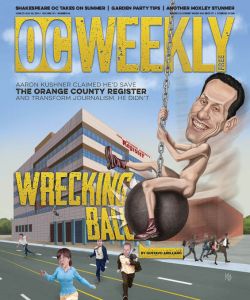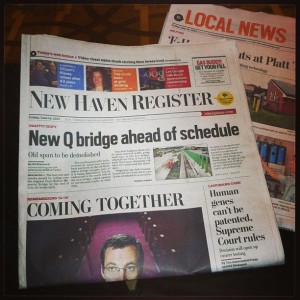Previously published at WGBHNews.org.
It looked like a one-off last month when The Denver Post rebelled against its hedge-fund owner. In publishing an editorial and several commentaries denouncing Alden Global Capital as “vulture capitalists,” the Post’s journalists took what was seen by most observers as a courageous but futile stand.
But now the rebellion is starting to spread. And there is hope, however slight, that Digital First Media — the newspaper chain controlled by Alden — can somehow be pushed into doing the right thing. As CNN media reporter Brian Stelter writes, there were protests scheduled for today in Denver and New York City, the latter to take place outside Alden’s headquarters.
What’s happening matters nationally, and it matters locally. Digital First is one of our largest newspaper chains, controlling nearly 100 newspapers on both coasts and at points in between. Locally, Digital First operates The Sun of Lowell, the Sentinel & Enterprise of Fitchburg, and, since earlier this year, the Boston Herald. So intent is Digital First on cutting costs that it actually closed the Sentinel’s offices, switching to a “virtual newsroom,” which is apparently now acceptable corporate-speak for “no newsroom.”
The rebellion against Digital First got a boost last week when Ken Doctor, citing documents he had obtained, reported in the Nieman Journalism Lab that the company had run up a profit margin of 17 percent in the 12-month period that ended on June 30, 2017. The Lowell and Fitchburg papers were particularly lucrative, with a profit of 26 percent. The numbers were shocking, as they demonstrated that the papers are generating more than enough money to cover their communities if only it wasn’t being siphoned off by Alden principal Randall Smith to buy mansions in Palm Beach, Florida.
At the moment, there are no signs of protests coming to Massachusetts — but that could change. And Colorado continues to be a hotbed of unrest. In his latest, Doctor reports that former Post owner Dean Singleton, known as a brutal cost-cutter when he was at the height of his powers years ago, is so appalled by the cuts that he’s resigned as chair of the Post’s editorial board. “At the end of my career, I don’t want to be a part of it,” Singleton said. “The Post has been totally gutted of news coverage and of editorial coverage. That’s a fact.”
Several others also resigned, including editorial-page editor Chuck Plunkett, who was the force behind the Post’s anti-Alden Capital package last month. The reason: Ownership refused to let him write about another Digital First property in Colorado, the Daily Camera of Boulder, where editorial-page editor David Krieger was fired after he self-published a rant that criticized Alden. Doctor writes that the Camera might simply eliminate the editorial pages — which, I’m told, has become common practice at Digital First’s smaller papers. Back in Denver, some 55 Post journalists signed an open letter, saying they were “outraged” at the silencing of Plunkett.
The uprising against Alden Capital demonstrates that there is still money in newspapers. In fact, though the technology-driven changes that have decimated newspaper revenues over the past 25 years are very real, they are only half the story. Debt-free newspapers that are rooted in the community, and that are not forced to ship their revenues off to greed-crazed owners, can still manage to turn a profit. And though virtually all newsrooms have shrunk in response to the changing economics of journalism, a 17 percent margin obviously requires a lot more blood on the floor than, say, a more modest goal of 5 to 10 percent.
The challenge is that corporate chain ownership, accompanied by unrealistic profit expectations, remains the prevailing business model in the newspaper business, notwithstanding a few wealthy owners who are trying to buck the tide. Locally, for example, more than 100 papers, including key dailies such as the Telegram & Gazette of Worcester, the Providence Journal, The MetroWest Daily News of Framingham, and The Patriot Ledger of Quincy, are owned by GateHouse Media, which is controlled by yet another hedge fund, Fortress Investment Group.
GateHouse has its own well-earned reputation for operating its newspapers on a shoestring. Unlike Digital First, though, GateHouse appears to be committed to staying in the newspaper business rather that choking out the last drop of value — which is why a lot of us thought GateHouse would be the lesser of two evils when Digital First emerged as a last-minute bidder for the Boston Herald. (As it turned out, Gatehouse won anyway: Digital First moved the Herald’s printing operation from The Boston Globe’s facility in Taunton to the Providence Journal.)
The only hope now is that outrage against Digital First will harm Alden Capital’s bottom line. Economic pressure combined with the emergence of civic-minded local buyers could provide these papers with a fresh start — as happened several years ago in Pittsfield, when Digital First sold the Berkshire Eagle (and several affiliated papers in Vermont) to a group of local business leaders.
If nothing else, the rebellion against Digital First should help educate the public that it doesn’t have to be this way. Run properly, newspapers can still make money while fulfilling their mission of holding government and other institutions to account. Getting the hedge funds out will not solve journalism’s long-term economic challenges. But it would be a welcome start.
Talk about this post on Facebook.








